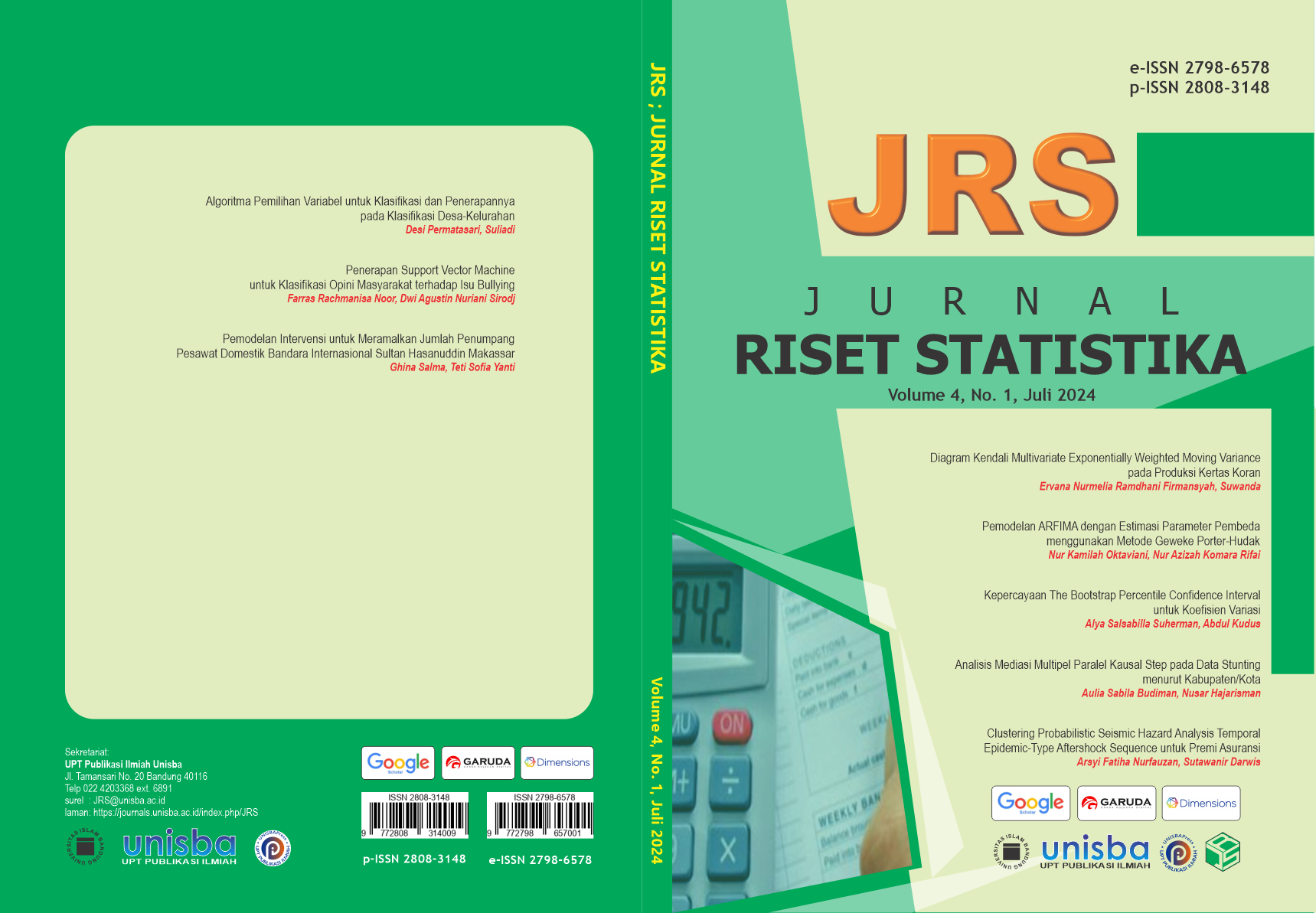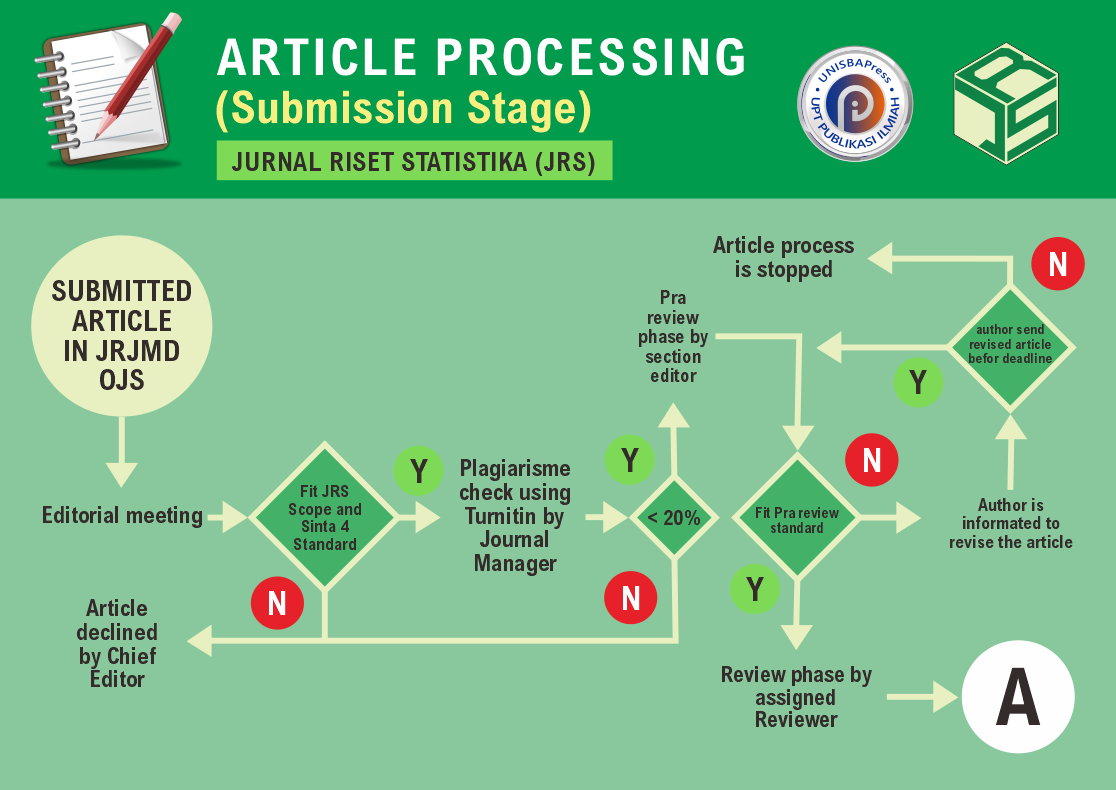Penerapan Support Vector Machine untuk Klasifikasi Opini Masyarakat Terhadap Isu Bullying
DOI:
https://doi.org/10.29313/jrs.v4i1.3877Keywords:
Bullying, Klasifikasi, SVMAbstract
Abstract. Support Vector Machine (SVM) concept is explained as an attempt to find the best hyperplane (separation function) that serves as a separator of two classes in the input space by maximizing the distance between classes (Alhaq, et al., 2021). This algorithm has proven to have good performance as a classification method, by producing a fairly good model accuracy value. This analysis process uses the Python programming language, the keywords used for crawling tweet data are a combination of the words bully/bullying and school/elementary school/junior high/high school, with a data retrieval period from November 1, 2022 to June 30, 2023, the results obtained are 13,918 tweets. Then preprocessing is carried out, at this stage the data that passes the classification process is 2,519 tweets with the number of positive sentiments 1,268 tweets and negative sentiments 1,251 tweets. Furthermore, the division of training and testing data with a ratio of 80:20. The application of the SVM algorithm produces an accuracy value of 84.5%, meaning that this method can predict the sentiment of the bullying issue tweet sentence with the category of good classification (Gorunescu, 2011), precision 84.7%, recall 82.9% and F1-score 83.8%. Overall, this model works well and consistently for the case of tweet data.
Abstrak. Support Vector Machine (SVM) dijelaskan sebagai usaha mencari hyperplane (fungsi pemisah) terbaik yang berfungsi sebagai pemisah dua buah kelas pada input space dengan memaksimalkan jarak antar kelas (Alhaq, et al., 2021). Algoritma ini sudah terbukti memiliki kinerja yang baik sebagai metode klasifikasi, dengan menghasilkan nilai akurasi model yang cukup baik. Proses analisis ini menggunakan bahasa pemrograman Python, kata kunci yang digunakan untuk crawling data tweet yaitu kombinasi kata bully/bullying dan sekolah/SD/SMP/SMA, dengan periode pengambilan data dari 1 November 2022 hingga 30 Juni 2023, hasilnya diperoleh 13.918 tweet. Kemudian dilakukan preprocessing, pada tahap ini data yang lolos dilanjutkan proses klasifikasi sebanyak 2.519 tweet dengan jumlah sentimen positif 1.268 tweet dan sentimen negatif 1.251 tweet. Selanjutnya pembagian data training dan testing dengan perbandingan 80:20. Penerapan algoritma SVM menghasilkan nilai accuracy sebesar 84.5%, artinya metode ini dapat melakukan prediksi sentimen dari kalimat tweet isu bullying dengan kategori good classification (Gorunescu, 2011), precision 84.7%, recall 82.9% dan F1-score 83.8%. Secara keseluruhan model ini bekerja dengan baik dan konsisten untuk kasus data tweet.
References
B. Raharjo, Pembelajaran Mesin (Machine Learning). Semarang: Yayasan Prima Agus Teknik, 2021.
S. Ramadinah, “Analisis Sentimen Twitter: Penanganan Pandemi Covid-19 Menggunakan Metode Hybrid Naïve Bayes, Decision Tree, dan Support Vector Machine,” UIN Jakarta, Jakarta, 2021.
R. Talib, M. Kashif, S. Ayesha, and F. Fatima, “Text Mining: Techniques, Applications and Issues,” International Journal of Advanced Computer Science and Applications, vol. 7, no. 11, 2016, doi: 10.14569/IJACSA.2016.071153.
A. Zahara and E. Kurniati, “Penerapan Ekstrim Fungsi untuk Menentukan Profit Maksimum dalam Pasar Persaingan Sempurna untuk Short-Run dan Long-Run,” DataMath: Journal of Statistics and Mathematics, vol. 2, no. 1, pp. 33–40, 2024.
A. D. Sofia and A. Kudus, “Pengelompokan Kabupaten/Kota berdasarkan Indikator Indeks Pembangunan Manusia 2022 Menggunakan K-Harmonic Means Clustering,” Jurnal Riset Statistika, vol. 3, no. 2, pp. 163–172, Dec. 2023, doi: 10.29313/jrs.v3i2.3130.
I. Cholissodin, Sutrisno, A. A. Soebroto, U. Hasanah, and Y. I. Febiola, AI, Machine Learning & Deep Learning (Teori & Implementasi). Malang: Universitas Brawijaya, 2020.
M. N. Muttaqin and I. Kharisudin, “Analisis Sentimen Aplikasi Gojek Menggunakan Support Vector Machine dan K Nearest Neighbor,” Journal of Mathematics, vol. 10, no. 2, pp. 22–27, 2021.
Z. Alhaq, A. Mustopa, S. Mulyatun, and J. D. Santoso, “Penerapan Metode Support Vector Machine Untuk Analisis Sentimen Pengguna Twitter,” Journal of Information System Management (JOISM), vol. 3, no. 2, pp. 44–49, Jul. 2021, doi: 10.24076/joism.2021v3i2.558.
F. Gorunescu, Data Mining: Concept, Models and Techniques. Berlin: Springer, 2011.
A. Firdaus, “ Aplikasi Algoritma K-Nearest Neighborpada Analisis Sentimen Omicron Covid-19,” Jurnal Riset Statistika, vol. 2, pp. 85–92, 2022.
Y. Romadhoni, “Klasifikasi Kalimat Perbincangan Masyarakat Terhadap Pandemi Covid-19 Pada Twitter Dengan Metode Long Short-Term Memory,” Universitas Islam Negeri Maulana Malik Ibrahim, Malang, 2022.













